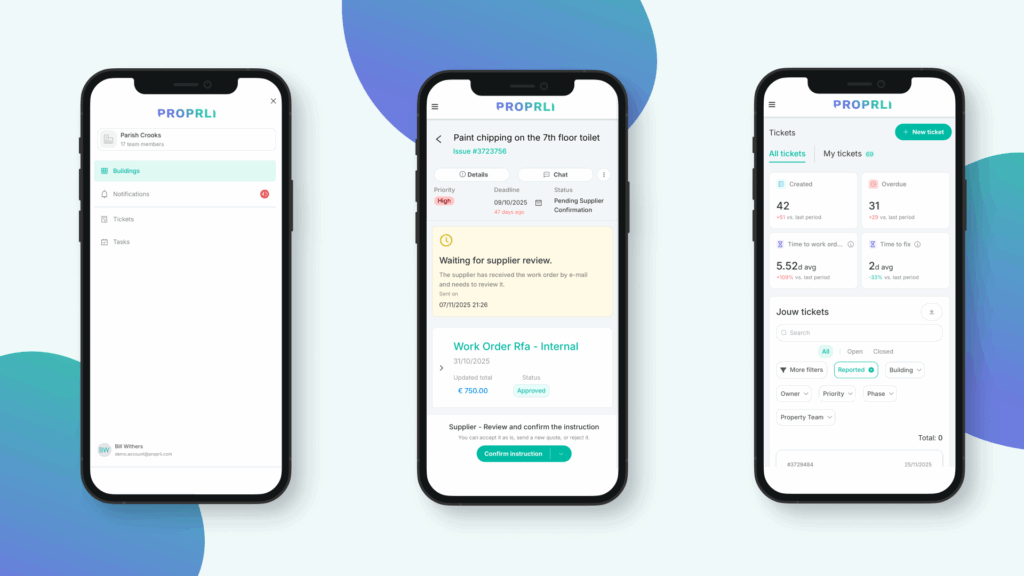In real estate, most things get fixed, eventually. A contractor is called. A ticket is resolved. A complaint is handled. A missing certificate is chased down. From the outside, it may look like things are working.
But this constant state of catching up comes at a cost: Time, trust, and control.
When issues are only addressed after they become visible, after the damage is done, after the tenant complains, after the compliance deadline passes, property management becomes reactive by default. Teams are always responding, rarely anticipating. And buildings are managed through urgency, not structure. This isn’t just inefficient. It’s unsustainable.
As portfolios grow, expectations rise, and regulations tighten, the reactive model breaks down. Not because people aren’t doing their jobs, but because the system itself is designed to wait for failure.
This article explores why that model no longer works, and what a proactive alternative looks like in practice. Not as a buzzword, but as a better operating system for the future of real estate.
Key Takeaways
- Reactive property management no longer meets the demands of modern portfolios. It leads to inefficiencies, rising costs, and lower tenant satisfaction.
- Proactive property management is not just about planning ahead, it’s about aligning stakeholders, building structure, and making data operational.
- Siloed systems and disconnected workflows make it impossible to work proactively. A shared environment anchored around the building is essential.
- Budget decisions made without operational context lead to short-term savings and long-term costs. Visibility enables smarter investment.
- The shift to proactivity requires cultural change, not just tools: standardization, team training, and measurable workflows.
- Proactive teams reduce surprises, build trust, and make room for strategic value, not just reaction.
The hidden cost of reactive workflows
Property management isn’t broken, but the way it’s often practiced is outdated. At the heart of most operational friction is a reactive model: only acting when something breaks, when a tenant complains, or when a deadline looms. It’s a mode built for survival, not for performance. And it makes sense, until it doesn’t.
Because when the stakes rise, the complexity deepens, and the portfolio scales, this way of working starts to fail. What begins as “we’ll fix it when it comes up” becomes a cycle of delays, escalations, unhappy tenants, frustrated teams, and ballooning costs. Firefighting becomes the norm. And the sense of control fades.
What’s missing isn’t more effort. It’s foresight. Structure. A proactive mindset backed by systems that make prevention the default, not the exception.
Proactive management: beyond planning, toward alignment
When people hear “proactive,” they often think of scheduling ahead, doing maintenance on time, or sending reminders early. But that’s just the beginning.
True proactive property management means anticipating needs across every stakeholder, and building systems that allow for seamless execution before problems emerge. It means aligning property managers, owners, suppliers, and tenants around a shared understanding of what needs to happen, why it matters, and who is responsible, long before any issue arises.
It’s not about working harder. It’s about designing a workflow where problems become visible sooner, communication becomes effortless, and operations become stable.
What it looks like in practice
In a proactive environment, daily property management feels different. Instead of chasing documents, you know where everything is. Instead of sending update emails, stakeholders already see the progress. Instead of running status meetings, you focus on decisions.
Here’s what it actually looks like:
| Strategy | Benefits |
|---|---|
| Scheduled inspections | Risks identified before they escalate |
| Predictive maintenance | Fewer unplanned repairs, better budgeting |
| Live task tracking | No need for status calls or email chains |
| Proactive tenant communication | Fewer complaints, higher satisfaction |
| Supplier accountability | Performance measured over time, not just by invoice |
| Integrated documentation | Nothing gets lost, and audits become painless |
The building itself becomes a living workflow, where tasks, documents, timelines, projects, contracts and people are tied together in one environment. You’re not just reacting faster, you’re working smarter.
Better buildings, better relationships
A reactive building breaks trust. A proactive building builds it. Tenants feel it first. Instead of unanswered requests or delayed responses, they experience predictability. Even when issues arise, they know the resolution is already in motion. This kind of reliability leads to longer leases and fewer disputes.
Property managers benefit next. With fewer crises to handle, their day shifts from inbox triage to meaningful work: reviewing budgets, planning improvements, managing relationships, and optimizing service delivery. Their role becomes more strategic.
And owners gain transparency without micromanagement. With structured processes and real-time visibility, they don’t have to ask, “What’s happening?” They already know. Which means meetings shift from reporting to decision-making.
Technology is not the solution. Structure is.
Every portfolio already uses technology like dashboards, helpdesks, spreadsheets, shared drives. But technology alone doesn’t solve the fragmentation.
The real transformation happens when you use technology to enforce structure:
- Workflows tied directly to buildings and systems.
- Tasks connected to documents, inspections, contracts, and people.
- Notifications tied to real deadlines, not just reminders.
- A single environment where everyone sees the same truth.
That’s when data becomes operational. Not a report at the end of the month, but a guide for what needs to happen today. Without structure, even the best tech becomes another disconnected layer. With structure, even simple tools become powerful.
Silos sabotage proactivity
Even when teams aim to be proactive, most fall short for one simple reason: they’re not operating from the same reality.
Asset managers work from financial forecasts. Property managers manage day-to-day tasks. Suppliers respond to work orders. Tenants file complaints. But none of them operate from a shared operational layer, a single place where data, decisions, documents, contracts and workflows come together in real time.
The result? Misalignment becomes inevitable.
- A budget is set without insight into technical backlog.
- A planned inspection misses the context of tenant complaints.
- A contractor closes a task, but no one sees it happened.
- A recurring issue is fixed five times before anyone realizes it’s systemic.
This isn’t just inefficient. It’s risky. Opportunities for long-term improvement are lost in short-term chaos. Small issues are treated in isolation instead of being solved systemically.
Proactive property management only works when everyone works in the same environment. One where the building is the anchor. One where every task is visible. One where decisions are contextual. One where planning, communication, and execution happen in sync.
When this environment doesn’t exist, even smart teams are forced into reactive mode, because no one has the full picture.
Better budgets start with better visibility
Another common barrier to proactive management is budget pressure. Especially in commercial real estate, maintenance budgets are often based on historical spend, not on forward-looking need.
But here’s the paradox: cutting maintenance to save costs often results in higher costs later on.
- Skipping inspections leads to surprise failures.
- Deferring proactive maintenance leads to tenant complaints.
- Complaints turn into tickets, which turn into repairs.
- Repairs are rushed, often repeated, and more expensive.
And suddenly, the savings are gone, and you end up spending even more.
What’s missing isn’t just more money. It’s structured visibility into where budget makes the biggest impact. When the building is managed in a proactive environment, decisions shift:
- From “What can we afford to fix this year?”
- To “What should we fix now to avoid cost and disruption later?”
This is where real estate strategy begins: not just allocating budget, but aligning it with data, performance, and long-term value.
How to change: training teams and shifting culture
Proactive property management doesn’t start with software. It starts with mindset. To change how a building is managed, you first have to change how teams think about their work:
Train for ownership, not just tasks
Teams need to understand the “why” behind proactive work. If maintenance is delayed, what’s the cost? If inspections are skipped, who is affected?
Standardize the basics
Create recurring workflows. Define what “done” looks like. Make the process repeatable before you make it digital.
Celebrate prevention
Recognize the moments where problems were avoided. Treat silence (no complaints, no breakdowns) as a sign of success, not invisibility.
Give context, not just instructions
Help teams see how their work contributes to the bigger picture. A maintenance technician who sees the tenant feedback is more likely to care about quality.
Make visibility the norm
Everyone (from owners to contractors) should be able to see what’s happening, without needing to ask. Transparency reduces pressure and builds trust.
Culture change takes time. But it also unlocks time. Every hour spent on structure pays off in days not spent on cleanup.
Barriers and blind spots
Why doesn’t everyone already work this way? Because reactive management hides its cost. It feels faster. It rewards urgency. And it’s deeply embedded in how portfolios have always operated. Here are the three most common blockers:
Time pressure
When every day is full of incoming issues, there’s no room to step back. But without that step, the cycle never ends.
Budget fear
Proactive systems may seem like a cost. But the price of disorganization is always higher—just harder to quantify.
Change resistance
New workflows mean new habits. But most resistance melts when teams see how much easier life gets with structure.
The solution? Start small. Prove it once. Expand deliberately. A pilot building. A fixed workflow. A measurable result. That’s the path forward.
A strategic future for property managers
The best property managers aren’t just problem solvers. They’re systems thinkers. They build workflows, not just responses. They manage expectations as much as tasks. And they turn technical operations into strategic leverage.
In a world where ESG reporting, compliance, and tenant satisfaction drive value, the future of property management will belong to those who plan, align, and execute with clarity.
The reactive era is ending. The proactive era has already begun.
FAQ
Why does reactive property management no longer work in today’s market?
Because reactive property management focuses on solving problems only after they occur. In today’s fast-paced real estate environment, with increasing tenant expectations, regulatory demands, and portfolio complexity, this leads to inefficiencies, delays, and rising costs. Property managers end up spending more time putting out fires than managing assets strategically.
What is the difference between proactive and preventive property management?
Preventive property management refers to regular scheduled tasks, such as planned maintenance. Proactive property management goes further, it includes anticipating tenant needs, aligning stakeholders, identifying risks early through data, and using technology to act before issues escalate. It’s a system-wide approach, not just a task list.
How can property managers transition from reactive to proactive workflows?
Start by standardizing recurring tasks and creating clear workflows tied to buildings, not inboxes. Train your team to focus on prevention and visibility, not just response. Use a centralized platform to connect maintenance, inspections, tenant communication, and supplier performance, all in real time. Start small, prove success, and scale.
How do I justify the cost of proactive property management tools to leadership or owners?
Use data to demonstrate the hidden cost of reactive work: repeated repairs, tenant turnover, delayed compliance, and low visibility. Then show how proactive systems reduce complaints, improve efficiency, and extend asset life. Tools that enable structure and foresight often pay for themselves through fewer emergencies and better tenant retention.
Is proactive property management only relevant to maintenance teams?
No, proactive property management touches every part of building operations: compliance, documentation, budgeting, supplier management, and tenant experience. Maintenance is just one piece. The proactive model benefits asset managers, property teams, and owners alike by connecting the dots between all operational layers.
Can proactive property management be implemented across large portfolios?
Yes. In fact, the bigger the portfolio, the more essential proactive management becomes. It’s the only scalable way to maintain quality, reduce operational risk, and keep stakeholders aligned. Structured processes, centralized systems, and standard workflows are key to scaling proactive practices effectively.
Do property managers still need meetings if everything is proactive and structured?
Yes, but the nature of meetings changes. With structured visibility in place, meetings become faster and more strategic. Instead of status updates and chasing information, they focus on decisions, planning, and performance. The right environment reduces noise and frees up time for what matters.






